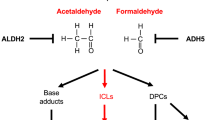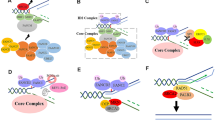Abstract
Analysis of peripheral blood lymphocytes in children born after the accident at the Chernobyl Nuclear Power Plant in the period from 1987 to 2004 (permanent residents of territories contaminated with radionuclides, n = 92; and children of irradiated fathers-liquidators, n = 88) revealed increased levels of aberrant cells (ACs) and aberrations of the chromosomal type as compared to the control (P < 0.05). In three subgroups of children with different initial AC frequencies (children with high AC frequencies, ≥3%; children with medium AC frequencies, 2%; and children with low AC frequencies, ≤1%), the levels of aberrations of the chromosomal type are increased as compared to the control (P < 0.05). The levels of aberrant cells and chromosome aberrations (CAs) in the subgroup of children with ≥3% frequencies significantly differ from those in the subgroup of children with ≤1% AC frequencies. No dependence of the AC and CA frequencies on the year of birth after the Chernobyl accident was revealed. After fractional and single γ-irradiation (137Cs) of blood in vitro in the 10–30 cGy dose range, the average CA frequencies in the first and second mitoses increased in a similar way depending on the initial AC frequencies in the children and parents. All these results suggest an individual character of genomic instability induced by low radiation doses and its transgenerational phenomenon in the organisms of children.
Similar content being viewed by others
References
Baleva, L.S., Sokha, L.G., and Yakovleva, I.N., Zdorov’e detei i radiatsiya: Aktual’nye problemy i resheniya (The Health of Children and Radiation: Problems and Solutions), Baleva, L.S. and Tsaregorodtsev, A.D., Eds., Moscow: Media Sphere, 2001.
WHO Health Effects of the Chernobyl Accident and Special Health Care Programmes, Bennett, B., Repacholi, M., and Carr, Z., Eds., Geneva, 2006.
UNSCEAR Non-Targeted and Delayed Effects of Exposure to Ionizing Radiation, Vienna, 2004.
Padovani, L., Stronati, L., and Mauro, F., et al., Cytogenetic Effect in Lymphocytes from Children Exposed to Radiation Fall-out after the Chernobyl Accident, Mutat. Res., 1997, vol. 395, pp. 249–254.
Gemignani, F., Balardin, M., and Maggiani, F., et al., Chromosome Aberrations in Lymphocytes and Clastogenetic Factors in Plasma Detected in Belarus Children 10 Years after Chernobyl Accident, Mutat. Res., 1999, vol. 446, pp. 245–253.
Fucic, A., Brunborg, G., Lasan, R., et al., Genomic Damage in Children Accidentally Exposed to Ionizing Radiation: A Review of the Literature, Mutat. Res., 2008, vol. 658, pp. 111–123.
Sevan’kaev, A.V., Mikhailova, G.F., Potetnya, O.I., and Tsepenko, V.V., Results of Dynamic Cytogenetic Study of Children and Teenagers Living in Areas, Radioactively Contaminated after the Chernobyl Accident, Radiat. Biol. Radioecol., 2005, vol. 45, pp. 5–15.
Stepanova, E.I., Misharina, E.I., and Vdovenko, V.Yu., Remote Cytogenetic Effects in Children Exposed in Prenatal Period after the Chernobyl Accident, Radiat. Biol. Radioecol., 2002, vol. 42, pp. 700–703.
Little, J.B., Radiation-Induced Genomic Instability, Int. J. Radiat. Biol., 1998, vol. 74, pp. 663–671.
Mazurik, V.K. and Mikhailov, V.F., Radiation-Induced Genome Instability: The Phenomenon, Molecular Mechanisms, Pathogenetical Significance, Radiation Biol. Radioecol., 2001, vol. 41, pp. 271–289.
Morgan, W.F., Non-Targeted and Delayed Effects of Exposure to Ionizing Radiation: I. Radiation-Induced Genomic Instability and Bystander Effects in vitro, Radiat. Res., 2003, vol. 159, pp. 567–580.
Pilinska, M.A., Dibski S.S., Dibska, O.V., and Pedan, L.R., Elucidate Chromosomal Instability in Offsprings of Fathers Irradiated as the Results of Chernobyl NPP, Tsitol. Genet., 2005, vol. 39, pp. 32–40.
Suskov, I.I. and Kuzmina, N.S., The Problem of Induced Genomic Instability in the Organism of Children under Conditions of Long-Term Exposure to Small Radiation Doses, Radiat. Biol. Radioecol., 2001, vol. 41, no. 5, pp. 606–614.
Kuzmina, N.S. and Suskov, I.I., Expression of Genomic Instability in Lymphocytes of Children Exposed to Prolonged Action of the Radiation Factor, Radiat. Biol. Radioecol., 2002, vol. 42, pp. 735–739.
Agadzhanyan, A. and Suskov, I., Modeling of Genomic Instability Using the Method of Biological Dose Accumulation after Fractional γ-Irradiation of Lymphocytes of Peripheral Blood of Children, Constantly Living in Radioactively Contaminated Areas and in Children of Liquidators of Accident at the Chernobyl Nuclear Power Plant, in Sovremennye problemy genetiki, radiobiologii, radioekologii i evolyutsii (Modern Problems of Genetics, Radioecology, and Evolution), Proc. 2nd Int. Conf. on the Occasion of the 105th Anniversary of N.V. Timofeev-Ressovsky, Korogodina, V.L., Chin’i, A.A., and Durante, M., Eds., Dubna: JINR, 2007, vol. 1, pp. 220–232.
Dubinin, N.P., Potentsial’nye izmeneniya v DNK i mutatsii (Potential Changes in DNA and Mutations), Moscow: Nauka, 1978.
Vorobtsova, I.E., Transgenerational Transmission of Radiation Induced Genomic Instability, Radiat. Biol. Radioecol., 2006, vol. 46, pp. 441–446.
Suskov, I.I., Agadzhanyan, A.V., Kuzmina, N.S., et al., The Problem of Transgeneration Phenomenon of Genome Instability in Ailing Children of Different Age Groups after the Accident at the Chernobyl Nuclear Power Plant, Radiat. Biol. Radioecol., 2006, vol. 46, pp. 466–474.
Suskov, I.I., Kuzmina, N.S., Suskova, V.S., et al., Individual Characteristics of Transgenerational Genomic Instability in Children of Liquidators of the Accident at the Chernobyl Nuclear Power Plant (Cytogenetic and Immunogenetic Characteristics), Radiat. Biol. Radioecol., 2008, vol. 48, pp. 278–286.
Morgan, W.F., Non-Targeted and Delayed Effects of Exposure to Ionizing Radiation: II. Radiation-Induced Genomic Instability and Bystander Effects in vivo, Clastogenic Factors and Transgenerational Effects, Radiat. Res., 2003, vol. 159, pp. 581–596.
Dubrova, Y.E., Radiation-Induced Transgenerational Instability, Oncogene, 2003, vol. 22, pp. 7087–7093.
Barber, R.C. and Dubrova, Y.E., The Offspring of Irradiated Parents, Are They Stable?, Mutat. Res., 2006, vol. 598, pp. 50–60.
Natarajan, A.T., Induced Transgenerational Genetic Effects in Rodents and Human, J. Radiat. Res., 2006, vol. 47, pp. 39–43.
Perry, P. and Wolff, S., New Giemsa Method for Differential Staining of Sister Chromatids, Nature, 1974, vol. 251, pp. 156–157.
Method of Human Chromosome Aberration Analysis, Buckton, K. and Evans, H., Eds., Geneva: WHO, 1976.
Biological Dosimetry: Chromosomal Aberration Analysis for Dose Assessment, Tech. Rep. Ser., Vienna: Int. Atomic Energy, 1986, no. 260, pp. 1–69.
Bratanov, Br., et al., Eds., Klinicheskaya pediatriya (Clinical Pediatric), Sofia: Meditsina i fizkul’tura, 1987, vol. 1, pp. 41–48.
Baranov, V.S. and Kuznetsova, T.V., Tsitogenetika embrional’nogo razvitiya cheloveka: nauchno-prakticheskie aspekty, (Cytogenetics of Human Embryonic Development: Scientific Practical Aspects), St. Petersburg: Izd. N-L., 2007
Streffer, C. and Tanooka, H., Biological Effects after Small Radiation Doses, Int. J. Radiat. Biol., 1996, vol. 69, pp. 629–272.
Burlakova, E.B., Goloshchapov, A.N., Zhizhina, G.P., and Konradov, A.A., New Aspects of Regulatory Action of Low Intensity Radiation, Radiat. Biol. Radioecol., 1999, vol. 39, pp. 26–34.
Scott, B.R., It,s Time for a New Low-Dose-Radiation Risk Assessment Paradigm-One That Acknowledges Hormesis, Dose Response, 2008, vol. 6940, pp. 333–351.
Pelevina, I.I., Aleshchenko, A.V, Afanasjev, G.G., et al., Phenomenon of enhanced Radiosensitivity of Lymphocytes after Low-Dose Adaptive Irradiation, Radiat. Biol. Radioecol., 2000, vol. 40, pp. 544–548.
Aghajanyan, A.V. and Suskov, I.I., Transgenerational Genomic Instability in Children of Irradiated Parents as a Result of the Chernobyl Nuclear Accident, Mutat. Res., 2009, vol. 671, pp. 52–57.
Suskov, I.I. and Kuzmina, N.S., Polygenomic Realization of Mutagenic Effects in the Organism of People Exposed to Low-Dose Radiation, Radiat. Biol. Radioecol., 2002, vol. 42, pp. 150–152.
Author information
Authors and Affiliations
Corresponding author
Additional information
Original Russian Text © A.V. Aghajanyan, I.I. Suskov, 2010, published in Genetika, 2010, Vol. 46, No. 6, pp. 834–843.
Rights and permissions
About this article
Cite this article
Aghajanyan, A.V., Suskov, I.I. Genomic instability in chidren born after the Chernobyl Nuclear Accident (in vivo and in vitro studies). Russ J Genet 46, 740–749 (2010). https://doi.org/10.1134/S1022795410060153
Received:
Published:
Issue Date:
DOI: https://doi.org/10.1134/S1022795410060153




